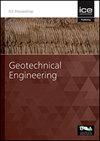既有桥梁新隧道跨桩基础分析方法&以实例为例
IF 1.7
4区 工程技术
Q3 ENGINEERING, GEOLOGICAL
Proceedings of the Institution of Civil Engineers-Geotechnical Engineering
Pub Date : 2023-10-12
DOI:10.1680/jgeen.23.00060
引用次数: 0
摘要
本文介绍了深圳湾大桥新隧道穿越桩基时隧道-桩相互作用的分析方法,并以基于空腔扩展的模型为例进行了分析。本研究建立的三维分析模型对地铁两条13号线和望海路隧道施工引起的地面变形和桩响应进行了评估,并对地面稳定和隔离墙等缓解措施的有效性进行了评估。研究表明,望海路隧道引起的竖向位移和地表沉降较大,特定桩基的水平变形弯矩较大。结果表明:加固措施能有效控制地层变形扰动,地铁射流系统隔墙能有效限制开挖引起的水平和竖向位移。为确保深圳湾跨海大桥的安全运行,本研究强调了对盾构穿越方案进行安全综合评价的重要性。本文提出的分析方法也可作为隧道施工优化的预设计工具和参考,为今后的加固方案提供有价值的指导。总的来说,本研究对隧道-桩相互作用提供了重要的见解,这将对桥梁和隧道工程的设计和施工有用。本文章由计算机程序翻译,如有差异,请以英文原文为准。
Analytical method for new tunnel crossing pile foundation of existing bridge: a case study
This paper describes an analytical method for investigating the tunnel–pile interaction for new tunnels crossing the pile foundation of the Shenzhen Bay Bridge, with a case study using a cavity expansion-based model. The three-dimensional analytical model developed in this study evaluates the ground deformation and pile response induced by the construction of tunnels for the two Metro #13 lines and the Wanghai Road tunnel, and assesses the effectiveness of mitigation measures such as ground stabilisation and isolation walls. The study reveals significant vertical displacement and surface settlement caused by the Wanghai Road tunnel, and horizontal deformation and bending moments in specific pile foundations. The results show that reinforcement measures can effectively control formation deformation disturbance, and metro jet system isolation walls can limit horizontal and vertical displacements caused by excavation. To ensure the safe operation of the Shenzhen Bay Bridge, the study highlights the importance of comprehensively evaluating the safety of shield crossing schemes. The proposed analytical method could also serve as a pre-design tool and reference for optimising tunnel construction, providing valuable guidance for future reinforcement schemes. In general, this study provides significant insights into the tunnel–pile interaction, which will be useful for bridge and tunnel engineering design and construction.
求助全文
通过发布文献求助,成功后即可免费获取论文全文。
去求助
来源期刊
CiteScore
4.40
自引率
4.50%
发文量
68
审稿时长
3 months
期刊介绍:
Geotechnical Engineering provides a forum for the publication of high quality, topical and relevant technical papers covering all aspects of geotechnical research, design, construction and performance. The journal aims to be of interest to those civil, structural or geotechnical engineering practitioners wishing to develop a greater understanding of the influence of geotechnics on the built environment.

 求助内容:
求助内容: 应助结果提醒方式:
应助结果提醒方式:


